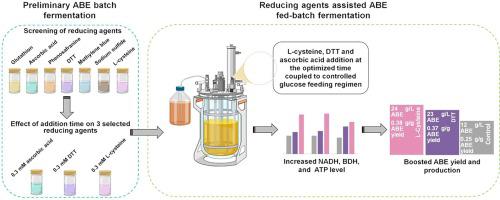当前位置:
X-MOL 学术
›
Energy Convers. Manag.
›
论文详情
Our official English website, www.x-mol.net, welcomes your
feedback! (Note: you will need to create a separate account there.)
Reducing agents assisted fed-batch fermentation to enhance ABE yields
Energy Conversion and Management ( IF 9.9 ) Pub Date : 2021-01-01 , DOI: 10.1016/j.enconman.2020.113627 Vijaya Chandgude , Teemu Välisalmi , Juha Linnekoski , Tom Granström , Bruna Pratto , Tero Eerikäinen , German Jurgens , Sandip Bankar
Energy Conversion and Management ( IF 9.9 ) Pub Date : 2021-01-01 , DOI: 10.1016/j.enconman.2020.113627 Vijaya Chandgude , Teemu Välisalmi , Juha Linnekoski , Tom Granström , Bruna Pratto , Tero Eerikäinen , German Jurgens , Sandip Bankar

|
Abstract Acetone-butanol-ethanol (ABE) fermentation process is a promising bioenergy option amid rising concerns over the environmental impact of fossil fuel usage. However, the commercialization of the ABE process has been marred by challenges of low product yield and titer, thereby non-competitive process economics. Here, we coupled cost competitive reducing agents with a controlled feeding strategy to improve both product titer and yield. Reducing agents promote cofactor dependent butanol production, while fed-batch operation enhances glucose consumption, final ABE titer, and partly mitigates product toxicity. The effects of ascorbic acid, L-cysteine, and dithiothreitol (DTT) on ABE fed-batch production using Clostridium acetobutylicum was investigated in current study. NADH, ATP, extracellular amino acid secretion, and NADH-dependent butanol dehydrogenase (BDH) assays were performed to study the metabolic modifications triggered by reducing agents. Incidentally, L-cysteine and DTT improved ABE solvent titer by 2-fold, producing 24.33 and 22.98 g/L ABE with solvent yields of 0.38 and 0.37 g/g, respectively. Elevated NADH, BDH, and ATP levels in fermentation broth reflected in enhanced ABE titer and yield. Furthermore, histidine secretion emerged as an important factor in Clostridial acid stress tolerance in this study. The results demonstrate that addition of reducing agents in fed-batch ABE fermentation operation enables efficient utilization of glucose with significant improvement in solvent production.
中文翻译:

还原剂辅助补料分批发酵以提高 ABE 产量
摘要 丙酮-丁醇-乙醇 (ABE) 发酵工艺是一种很有前景的生物能源选择,因为人们越来越担心化石燃料使用对环境的影响。然而,ABE 工艺的商业化受到产品收率和滴度低的挑战,从而导致非竞争性工艺经济性的挑战。在这里,我们将具有成本竞争力的还原剂与受控进料策略相结合,以提高产品滴度和产量。还原剂促进辅因子依赖性丁醇生产,而分批补料操作可提高葡萄糖消耗、最终 ABE 滴度,并部分减轻产品毒性。在当前的研究中,研究了抗坏血酸、L-半胱氨酸和二硫苏糖醇 (DTT) 对使用丙酮丁醇梭菌的 ABE 补料分批生产的影响。NADH、ATP、细胞外氨基酸分泌、和 NADH 依赖性丁醇脱氢酶 (BDH) 测定用于研究由还原剂引发的代谢修饰。顺便提一下,L-半胱氨酸和 DTT 将 ABE 溶剂滴度提高了 2 倍,分别产生 24.33 和 22.98 g/L ABE,溶剂收率分别为 0.38 和 0.37 g/g。发酵液中 NADH、BDH 和 ATP 水平的升高反映在 ABE 效价和产量的提高上。此外,在本研究中,组氨酸分泌成为梭菌酸胁迫耐受的重要因素。结果表明,在补料分批 ABE 发酵操作中添加还原剂能够有效利用葡萄糖并显着改善溶剂生产。L-半胱氨酸和 DTT 将 ABE 溶剂滴度提高了 2 倍,分别产生 24.33 和 22.98 g/L ABE,溶剂产量分别为 0.38 和 0.37 g/g。发酵液中 NADH、BDH 和 ATP 水平的升高反映在 ABE 效价和产量的提高上。此外,在本研究中,组氨酸分泌成为梭菌酸胁迫耐受的重要因素。结果表明,在补料分批 ABE 发酵操作中添加还原剂能够有效利用葡萄糖并显着改善溶剂生产。L-半胱氨酸和 DTT 将 ABE 溶剂滴度提高了 2 倍,分别产生 24.33 和 22.98 g/L ABE,溶剂产量分别为 0.38 和 0.37 g/g。发酵液中 NADH、BDH 和 ATP 水平的升高反映在 ABE 效价和产量的提高上。此外,在本研究中,组氨酸分泌成为梭菌酸胁迫耐受性的重要因素。结果表明,在补料分批 ABE 发酵操作中添加还原剂能够有效利用葡萄糖并显着改善溶剂生产。在本研究中,组氨酸分泌成为梭菌酸胁迫耐受的重要因素。结果表明,在补料分批 ABE 发酵操作中添加还原剂能够有效利用葡萄糖并显着改善溶剂生产。在本研究中,组氨酸分泌成为梭菌酸胁迫耐受的重要因素。结果表明,在补料分批 ABE 发酵操作中添加还原剂能够有效利用葡萄糖并显着改善溶剂生产。
更新日期:2021-01-01
中文翻译:

还原剂辅助补料分批发酵以提高 ABE 产量
摘要 丙酮-丁醇-乙醇 (ABE) 发酵工艺是一种很有前景的生物能源选择,因为人们越来越担心化石燃料使用对环境的影响。然而,ABE 工艺的商业化受到产品收率和滴度低的挑战,从而导致非竞争性工艺经济性的挑战。在这里,我们将具有成本竞争力的还原剂与受控进料策略相结合,以提高产品滴度和产量。还原剂促进辅因子依赖性丁醇生产,而分批补料操作可提高葡萄糖消耗、最终 ABE 滴度,并部分减轻产品毒性。在当前的研究中,研究了抗坏血酸、L-半胱氨酸和二硫苏糖醇 (DTT) 对使用丙酮丁醇梭菌的 ABE 补料分批生产的影响。NADH、ATP、细胞外氨基酸分泌、和 NADH 依赖性丁醇脱氢酶 (BDH) 测定用于研究由还原剂引发的代谢修饰。顺便提一下,L-半胱氨酸和 DTT 将 ABE 溶剂滴度提高了 2 倍,分别产生 24.33 和 22.98 g/L ABE,溶剂收率分别为 0.38 和 0.37 g/g。发酵液中 NADH、BDH 和 ATP 水平的升高反映在 ABE 效价和产量的提高上。此外,在本研究中,组氨酸分泌成为梭菌酸胁迫耐受的重要因素。结果表明,在补料分批 ABE 发酵操作中添加还原剂能够有效利用葡萄糖并显着改善溶剂生产。L-半胱氨酸和 DTT 将 ABE 溶剂滴度提高了 2 倍,分别产生 24.33 和 22.98 g/L ABE,溶剂产量分别为 0.38 和 0.37 g/g。发酵液中 NADH、BDH 和 ATP 水平的升高反映在 ABE 效价和产量的提高上。此外,在本研究中,组氨酸分泌成为梭菌酸胁迫耐受的重要因素。结果表明,在补料分批 ABE 发酵操作中添加还原剂能够有效利用葡萄糖并显着改善溶剂生产。L-半胱氨酸和 DTT 将 ABE 溶剂滴度提高了 2 倍,分别产生 24.33 和 22.98 g/L ABE,溶剂产量分别为 0.38 和 0.37 g/g。发酵液中 NADH、BDH 和 ATP 水平的升高反映在 ABE 效价和产量的提高上。此外,在本研究中,组氨酸分泌成为梭菌酸胁迫耐受性的重要因素。结果表明,在补料分批 ABE 发酵操作中添加还原剂能够有效利用葡萄糖并显着改善溶剂生产。在本研究中,组氨酸分泌成为梭菌酸胁迫耐受的重要因素。结果表明,在补料分批 ABE 发酵操作中添加还原剂能够有效利用葡萄糖并显着改善溶剂生产。在本研究中,组氨酸分泌成为梭菌酸胁迫耐受的重要因素。结果表明,在补料分批 ABE 发酵操作中添加还原剂能够有效利用葡萄糖并显着改善溶剂生产。











































 京公网安备 11010802027423号
京公网安备 11010802027423号